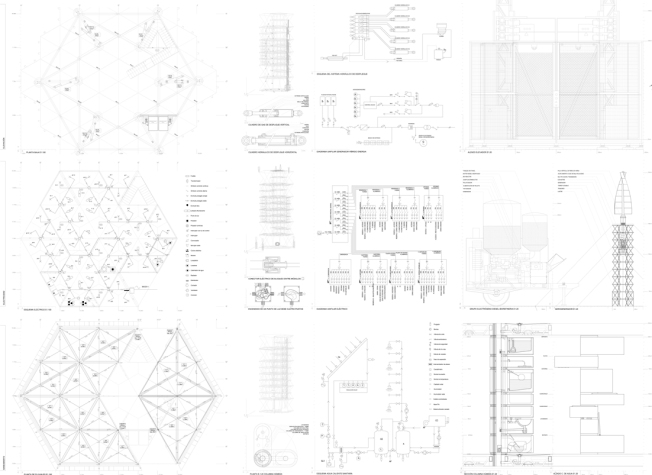Rodrigo García González
Madrid / Spain
2010
Photography courtesy http://www.zipizip.com
A lo largo de los tiempos se ha ido cultivando la idea de las construcciones asentadas, situadas en un lugar o contexto concreto, espacios inmóviles y prácticamente inmutables.
Pero ¿quién no ha pensado alguna vez (y sobre todo actualmente, donde la movilidad y los cambios de residencia están a la orden del día) en convertirse en un caracol y poder portar la vivienda y pertenencias tras de sí?
Con el nombre de ZIPIZIP el arquitecto español Rodrigo García desarrolla un sistema estructural plegable y transportable, que permite el cambio de contexto fácilmente.
Partiendo del estudio de referencias notorias dentro de este campo como son los trabajos de Buckminster Fuller o Emilio Pérez Piñero reinventa el concepto de fractalidad estructural para adecuarla a las necesidades modernas de densidad edificatoria, donde el uso de construcciones temporales y de fácil construcción pueden ser de gran ayuda tanto en ámbitos urbanísticos (como por ejemplo Juegos Olímpicos, Exposiciones temporales, Obras públicas…) como más privadas, acercando la posibiliadad de emancipación a muchas personas que hasta ahora pensaban que se tratase de una idea utópica e irreal en estos tiempos.
Abordando las características tecnológicas nos topamos con un sistema de mallas reticulares y nudos articulados que conforman el conjunto que se unen en forma de tijeras que facilita la construcción y desarme de la propia estructura de forma sencilla y sin necesidad de elementos externos.
La posibilidad de creación de subestructuras de menor grado en el interior permiten jugar con la configuración arquitectónica del proyecto que desemboca en plantas y secciones libres donde tanto los mobiliarios desplegables como las diferentes instalaciones y pieles que completarían el edificio contienen ese lenguaje de autosuficiencia y portabilidad de la que habla el conjunto.
Con su proyecto Rodrigo planta las bases de un concepto que puede llegar a desarrollarse y personalizarse por cada uno de nosotros.
Throughout the years, the concept of established constructions in specific contexts and in immobile and immutable spaces was created. Who hasn’t once thought of (and especially now that mobility and relocations are more common) becoming a snail, carrying their home and belongings wherever they go?
The Spanish architect Rodrigo García developed — ZIPIZIP— an adjustable and movable structural system that allows easy contextual change.
Parting from the studies of notorious references in the field, such as Buckminster Fuller or Emilio Pérez Piñero, the concept of structural fractality is reinvented to conform to the modern necessities of building density, where the use of temporary and easy constructions could greatly benefit urban environments (i.e. the Olympic Games, temporary exhibitions, and public works) as well as private ones. As a result it led to the emancipation of people who, up till now, thought that this idea was unrealistic or utopian for its time.
By addressing technological features we face a system, a grid mesh and nodes that make up the whole piece in the form of scissors, which facilitates the construction and dismantling of the structure in a simple way and without the need of external elements.
The possibility of creating substructures of lesser grade allows us to play with the architectural configuration of the project that results in plants and free sections where furniture as well as the various facilities and skins complete the building through a language of self-sufficiency and portability in the set.
With his project Garcia establishes the foundations of a concept that could be developed and personalized for us.






